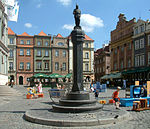Wielkopolska Museum of Independence

Wielkopolska Museum of Independence is a museum, a local cultural institution organized by the city of Poznań. The scope of the museum's activities includes collecting and making available collections on the independence uprisings and organic work during the partitions, the period of the Second Republic of Poland, fighting and martyrdom during World War II, as well as protests and opposition activities in the years 1945-1989. Before the name was changed, the museum was known as the Wielkopolska Museum of the Fight for Independence.The Chairman of the Museum Council in the 2016–2020 term is professor Zbigniew Pilarczyk from Adam Mickiewicz University, while the Director is Tomasz Łęcki.The museum is entered in the list of museums kept by the minister in charge of culture and national heritage protection.
Excerpt from the Wikipedia article Wielkopolska Museum of Independence (License: CC BY-SA 3.0, Authors, Images).Wielkopolska Museum of Independence
Stary Rynek, Poznań Stare Miasto
Geographical coordinates (GPS) Address Website Nearby Places Show on map
Geographical coordinates (GPS)
| Latitude | Longitude |
|---|---|
| N 52.4083 ° | E 16.9331 ° |
Address
Odwach/ Muzeum Powstania Wielkopolskiego 1918-1919
Stary Rynek 3
61-772 Poznań, Stare Miasto
Greater Poland Voivodeship, Poland
Open on Google Maps











